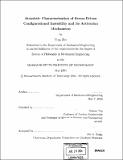Atomistic characterization of stress-driven configurational instability and its activation mechanisms
Author(s)
Zhu, Ting, 1971-
DownloadFull printable version (13.96Mb)
Other Contributors
Massachusetts Institute of Technology. Dept. of Mechanical Engineering.
Terms of use
Metadata
Show full item recordAbstract
Cleavage decohesion and shear dislocation nucleation are two basic modes of localized deformation in crystal lattices, which normally result from instability of the atomic configuration driven by mechanical forces. The critical state of instability and its thermal activation mechanisms can be quantitatively determined by analyzing the energetics of the lattice system. In this thesis, the unit processes of configurational instability of crystal lattices under various non-uniform structural and/or chemical environments are characterized by systematically probing the atomistic potential energy landscape of each system using the state of the art configurational space sampling schemes. The problems studied are homogeneous dislocation nucleation in a perfect crystal by nanoindentation, dislocation emission and cleavage decohesion at atomically sharp crack tips, and chemically-enhanced bond breaking in a wet silica nanorod. These processes are studied in a unified manner such that two important types of properties are determined: one is the athermal load at which the instability takes place instantaneously without the aid of thermal fluctuations, and the other is the stress-dependent activation energy used for an estimate of the kinetic rate of transition. Along the way, important aspects concerning the atomistic characterization of configurational instability are revealed. Of particular note is extending the continuum instability criterion to detect atomic defect nucleation. We demonstrate that a local instability criterion can be applied to identify dislocation nucleation in the case of indentation, considering that the relatively small strain gradient beneath the indenter will lead to a mode of long wavelength phonon instability suitable for a study (cont.) by the local continuum approach. In addition, the chemical effect on stress-driven lattice instability is revealed via the study on reactivity of a silica nanorod with water. We identify distinct competing mechanisms of hydrolysis which are rate-controlling at different load regimes. The ensuing stress-mediated switch of rate-limiting steps of hydrolysis quantitatively demonstrates the impact of finding the detailed molecular mechanisms on a realistic estimate of the activation rate when configurational instability occurs within a chemically reactive environment. Implications regarding the analysis of chemically-assisted brittle fracture are also discussed.
Description
Thesis (Ph. D.)--Massachusetts Institute of Technology, Dept. of Mechanical Engineering, 2004. Includes bibliographical references (p. 145-156).
Date issued
2004Department
Massachusetts Institute of Technology. Department of Mechanical EngineeringPublisher
Massachusetts Institute of Technology
Keywords
Mechanical Engineering.